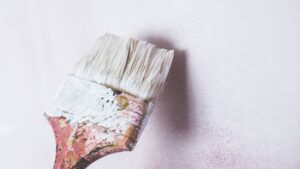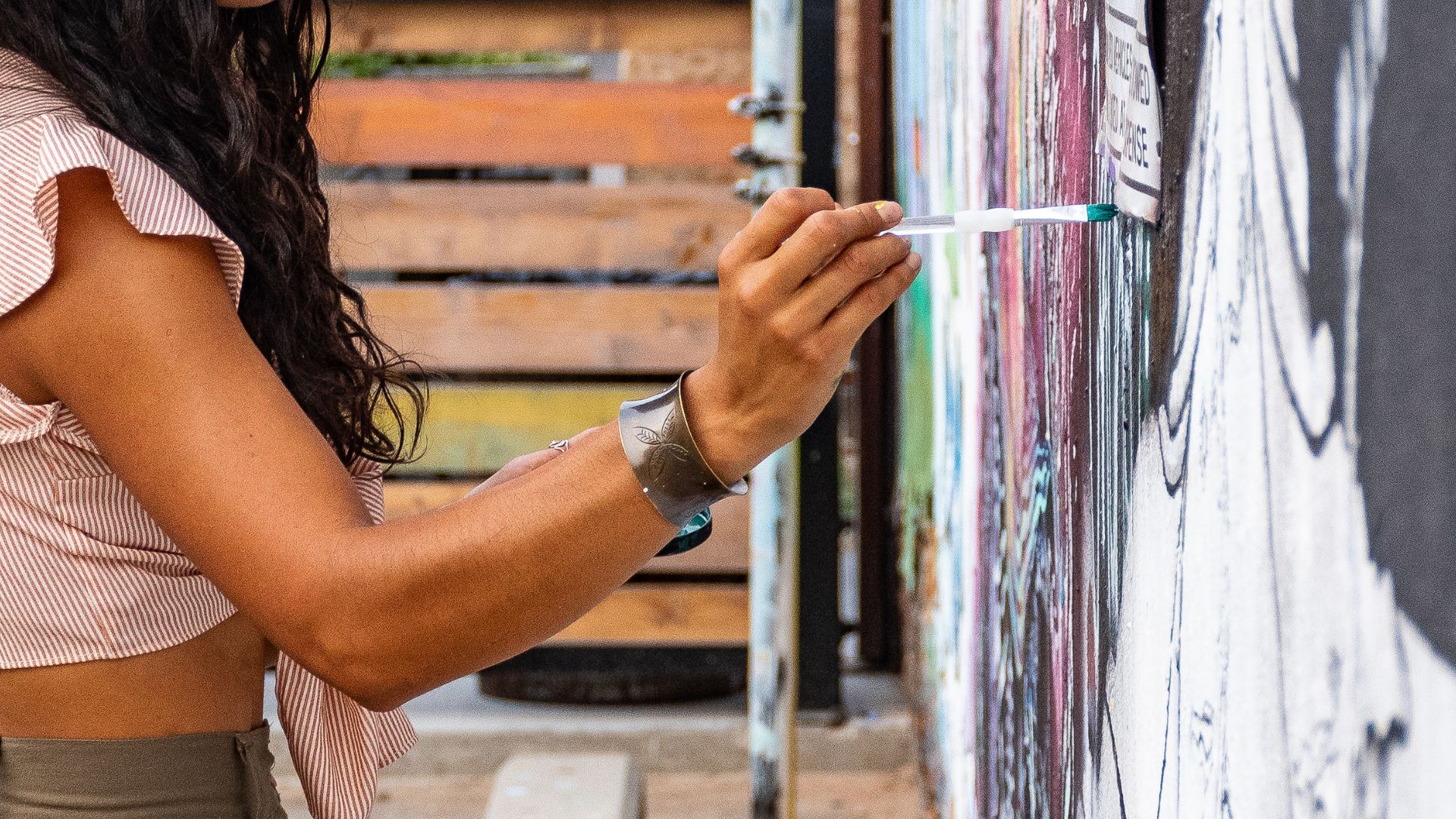Whether you’re an experienced artist or venturing into mural painting for the first time, ensuring safety should always be a top priority. Painting a mural can be an exciting and fulfilling creative endeavor, but it’s crucial to take certain precautions to safeguard your health and well-being throughout the process.
1. Choose the Right Location
Before you start painting, select a well-ventilated area with adequate lighting. Ensure the space is free from potential hazards like uneven ground or overhead obstacles to prevent accidents while you work.
2. Wear Appropriate Safety Gear
Invest in the right safety equipment to protect yourself from potential risks. Wear comfortable clothing that you don’t mind getting paint on and consider using protective gear such as:
Safety Glasses: Shield your eyes from paint splatters, debris, or accidental contact with chemicals.
Respirator or Mask: Especially when working with aerosol paints or in poorly ventilated areas to avoid inhaling harmful fumes.
Gloves: Protect your hands from paint, chemicals, or rough surfaces.
3. Use Non-Toxic Paints
Opt for non-toxic, environmentally friendly paints to minimize health risks. Water-based acrylic paints are generally safer than solvent-based ones, emitting fewer fumes and being easier to clean up.
4. Proper Ventilation
Ensure adequate ventilation in the painting area. If indoors, open windows and use fans to improve air circulation. This helps in dissipating paint fumes and prevents you from inhaling harmful chemicals.
5. Handle Ladders and Equipment Safely
If you’re working on a large mural that requires a ladder or scaffolding, follow safety guidelines:
Stable Support: Place ladders on a firm, level surface and use safety locks if available.
Safety Harnesses: Consider using a harness or securing yourself when working at heights.
Proper Equipment Handling: Handle brushes, rollers, and other tools with care to avoid injuries.

6. Stay Hydrated and Take Breaks
Painting a mural can be physically demanding. Remember to stay hydrated by drinking water regularly and take breaks to rest your body and eyes to prevent fatigue.
7. Clean Up Properly
After completing your mural, clean up the area carefully. Dispose of paint cans, brushes, and other materials responsibly, following local waste disposal guidelines.
So,…
Prioritizing safety while painting a mural is key to a successful and enjoyable experience. By taking these precautions, you not only protect yourself but also ensure a smooth and fulfilling artistic process.
Remember, your health and safety matter most. So, equip yourself with the right tools, maintain a safe environment, and enjoy the creative journey of mural painting!
For further information and resources on mural painting safety, check out these helpful links:
Understanding the Risks and Mitigating Hazards in Mural Painting
Painting a mural is not just about creativity; it’s also about ensuring a safe and secure environment for yourself and those around you. Let’s delve deeper into some of the risks involved and additional precautions you can take:
Understanding Paint Chemicals
- Volatile Organic Compounds (VOCs): Many paints contain VOCs that can evaporate into the air, potentially causing health issues when inhaled over time. Opt for low-VOC or VOC-free paints to minimize these risks.
- Lead-based Paints: If you’re working on an older surface, be cautious about lead-based paint. It’s essential to verify the paint’s composition, especially when sanding or scraping surfaces, as lead exposure can be hazardous to health.
Preventing Accidents
- Fire Safety: Avoid smoking near painting materials, especially those that are flammable. Keep fire extinguishers nearby, especially if you’re working with aerosols or other flammable substances.
- Electricity and Water: If your mural involves electrical outlets or fixtures, take extra care to avoid contact with water or wet materials. Ensure all electrical sources are safely covered or turned off.
Personal Health
- Skin Protection: Some paints and chemicals can cause skin irritation or allergic reactions. Wear long sleeves and pants to protect your skin and use barrier creams or gloves if needed.
- Respiratory Health: A respirator or mask is vital when working with spray paints or in poorly ventilated spaces. Ensure the mask fits properly to effectively filter out harmful particles.
Environmental Considerations
- Waste Disposal: Dispose of paint cans, brushes, and other materials responsibly. Some paints and solvents can be harmful to the environment if not disposed of correctly.
Seek Professional Advice
If you’re uncertain about any aspect of safety while painting your mural, don’t hesitate to seek guidance from professionals. Local health and safety organizations or art supply stores may offer valuable insights specific to your project.
Conclusion
Safety should never be overlooked when creating art, including murals. By understanding the potential risks and taking proactive measures to mitigate them, you not only protect yourself but also create a safer environment for everyone involved in the creative process.
Remember, each mural project is unique, so assess the risks accordingly and tailor your safety measures to suit the specific requirements of your artwork and workspace.
For further reading on mural painting safety and health:
Comparison tabular
Here’s a comparison table summarizing the key safety precautions for painting a mural:
| Safety Precautions | Description |
|---|---|
| Location Selection | Choose a well-ventilated, hazard-free area for painting. |
| Proper Safety Gear | Wear safety glasses, respirator, gloves, and appropriate clothing. |
| Non-Toxic Paints | Opt for environmentally friendly, non-toxic paint options. |
| Ventilation | Ensure good airflow by opening windows or using fans. |
| Equipment Handling | Use ladders and tools properly, ensuring stability and safety. |
| Hydration and Breaks | Stay hydrated and take regular breaks to prevent fatigue. |
| Cleanup | Dispose of materials responsibly according to local guidelines. |
| Understanding Chemicals | Be aware of paint components like VOCs and lead-based paints. |
| Fire and Electrical Safety | Prevent fire hazards and be cautious with electrical sources. |
| Skin and Respiratory Health | Protect skin from irritation and use a mask when needed. |
| Waste Disposal | Properly dispose of paint cans and other materials to avoid environmental harm. |
This table summarizes the essential safety measures to consider while painting a mural, ensuring a safe and enjoyable artistic experience. Remember, prioritizing safety is key to a successful and fulfilling creative endeavor!
Wrapping up
Prioritizing safety while painting a mural not only safeguards your well-being but also enhances the joy of the creative process. By adopting these safety precautions, you’re ensuring a secure environment for yourself and those around you.
Always remember that safety measures aren’t limitations; they’re the foundation upon which your artistic journey thrives. So, embrace your creativity, paint boldly, and let your imagination flourish within the boundaries of a safe and secure workspace.
By understanding the risks, employing preventive measures, and staying informed about safe practices, you’re not just creating art you’re nurturing a culture of safety and well-being within your artistic community.
So, pick up your brushes, choose your colors, and paint your masterpiece, all while prioritizing safety at every stroke. Your artistry deserves a safe and secure canvas to thrive upon. Stay safe, stay inspired, and let your creativity soar.

For over a decade, I’ve been Mike, an artist, crafter, and designer deeply immersed in the Croc world. I thrive on crafting unique, size-inclusive patterns, fostering creativity, and sharing them on ktforum.com. My designs aim to ignite your creative spark and delight you, ensuring clarity and ease of use through rigorous testing. Join me in expressing your creative flair and showcasing your craft with joy.
Related Posts
- Choosing the Right Paintbrush for Mural Painting
Painting a mural is an exciting and expressive way to transform a space, but selecting…
- Accessibility in Mural Painting: Scaffolding vs. Ladders
When it comes to mural painting, ensuring accessibility isn’t just a matter of convenience it's…
- The Ideal Weather Conditions for Painting an Outdoor Mural
Creating an outdoor mural is an exciting project that adds vibrancy and personality to a…
- The Best Time of Day for Painting an Outdoor Mural
When it comes to painting an outdoor mural, choosing the right time of day can…

